Transparency is one of the cornerstones of effective project management, especially trying to build better client relationships that make WordPress development projects smoother and more efficient.
That’s why here at White Canvas, we have adopted clear and open communication practices to manage expectations, solve problems and achieve client goals more efficiently.
In this article, we share some success stories, key practices, and lessons learned that have demonstrated the value of transparency in project management.
Why Transparency is Key in Project Management
Open and honest communication is essential in any project, not only to build trust, but also to avoid misunderstandings and associated issues during any stage of the process, from design research to website deployment.
At White Canvas, we believe that transparency improves client satisfaction and allows for more effective risk and resource management.
By sharing key information up front on our commercial proposals and during regular meetings, clients have a clear view of timelines, budget, project scope, and potential challenges, facilitating smoother collaboration and more informed decision-making.
Our Experience With the Benefits of Transparency During a Web Redesign Project
One of our most successful projects in terms of transparency communication was the redesign and development of a website in collaboration with an external design agency.
In this project, the agency proposed the possibility of starting with the desktop designs while the mobile designs would be delivered later. While this seemed like a quick fix, White Canvas was transparent about the associated risks.
We explained to the client and the agency that this approach could duplicate development and testing efforts, putting both the budget and delivery schedule at risk.
By being clear about the potential implications, we gained a mutual understanding of the difficulties that could arise and collaborated on a more efficient strategy: prioritizing the end-to-end design of key pages, such as the homepage, before moving forward with development.
This decision allowed us to avoid delays and misunderstandings, keeping the project on schedule.
How Transparency Comes Into Play When Setbacks Appear
Setbacks are inevitable in complex WordPress development projects, but how we handle them can make all the difference. We always try to communicate any problems as early as possible to ensure the client is up-to-date and our team members have room to maneuver for solutions.
Rather than waiting, we communicate the situation to the client immediately, explaining the causes of the delay and the options available to move forward.
We offer several solutions, clearly explaining the implications of each, allowing the customer to make an informed decision. This transparency helps maintain trust and turns a potential problem into an opportunity to strengthen the relationship with the customer.
How Transparency Improves Client Satisfaction
The feedback we have received from our clients about our efforts to be as transparent as possible has been consistently positive.
One case in particular stands out. A client requested design changes near the end of development, which put budget and delivery dates at risk.
We were clear about the implications of implementing the changes at that point and helped the client make an informed decision, prioritizing what was most important to their business at the time: meeting the delivery date.
Ultimately, the client appreciated our honesty and clarity, strengthening our relationship.
Based on this and other experiences where we’ve been clear about the implications of various decisions, we have solidified our belief that being transparent is also an excellent way to improve client satisfaction.
The Tools We Use to Report to Clients and Maintain Transparency
Our main tool for maintaining transparency and keeping clients informed is Notion. More specifically, we have been leaning more toward our Client Dashboard, a Notion dashboard we create for each project.
Previously, we felt we didn’t provide enough clarity for clients, leading to frequent questions about which stage of the project we were in, upcoming milestones, and delivery times. This led to an inefficient, constant flow of information that made the process more difficult.
The Client Dashboard addresses this need by providing a full breakdown of the project, including specific tasks and timelines for sprints and project stages.
Since adopting it, the Client Dashboard has become an integral part of our project management, and we continue to polish it to improve the customer experience.
It not only provides real-time visibility for the project’s progress, but also facilitates transparency by providing a centralized space for reports, metrics, and updates.
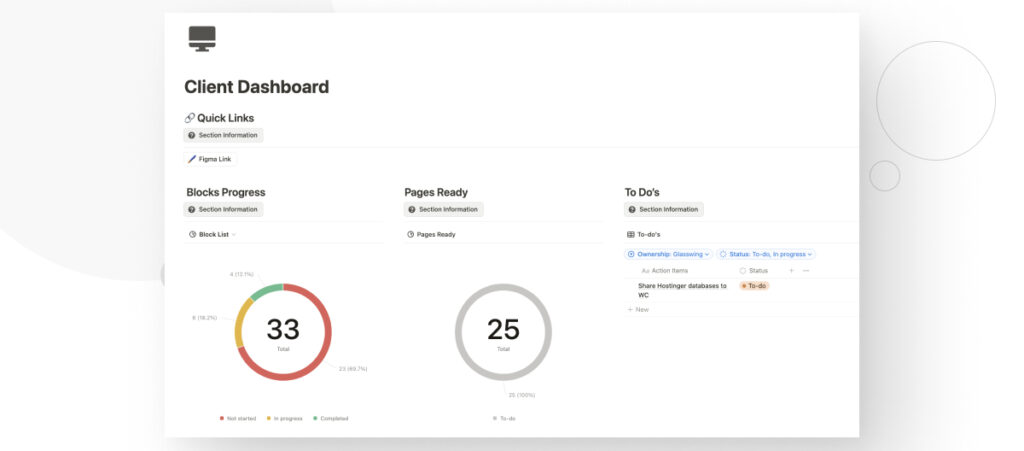
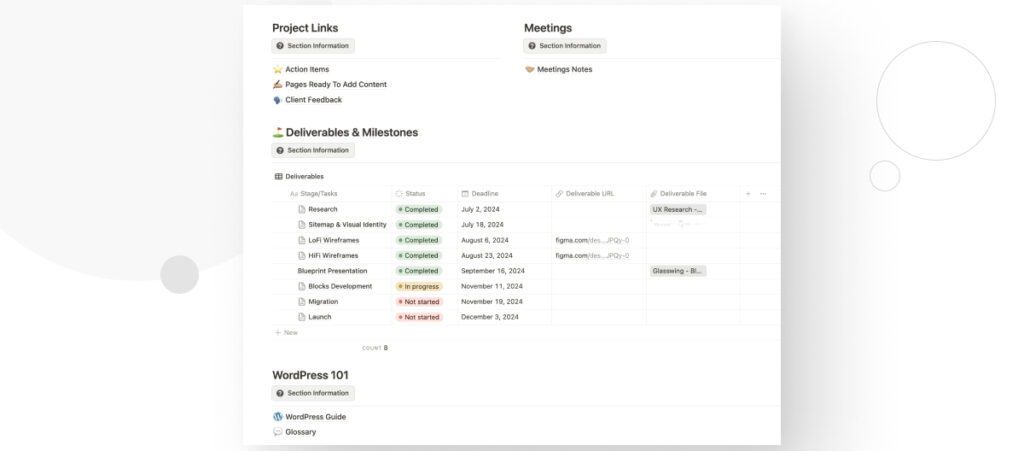
In addition to Notion, we use Asana for tracking tasks and ensure that milestones are met in an orderly fashion.
Also, weekly meetings via Meet and asynchronous communication via Slack or email ensure that urgent issues are addressed quickly, and everyday communication remains accessible and transparent.
Transparency Helped Us Build Better Client Relationships in WordPress Development Projects
Throughout our experiences with various clients and projects, we have learned that transparency is a principle we must continue to strengthen in all our projects if we want to build better client relationships.
Transparency in communication, especially during unexpected setbacks, has proven to be one of our strengths and a great source of client satisfaction.
As we continue to learn from our experiences, we are committed to further improving our transparency and communication practices to provide even more effective and valuable service. We will continue to adopt this approach to ensure our clients always feel informed and empowered throughout each project.
If you found this post useful, read our blog and developer resources for more insights and guides!
Related Articles
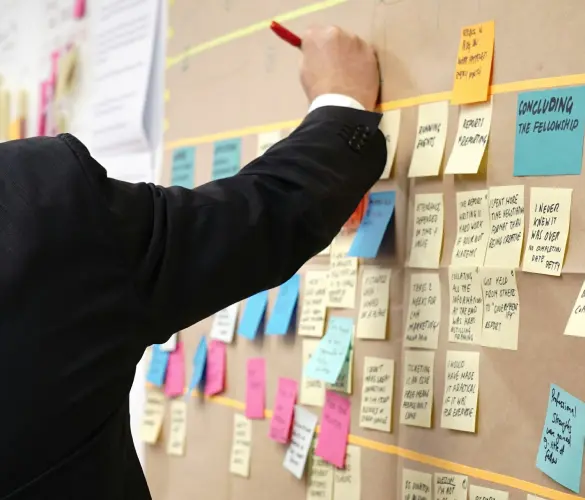
Business / 12 min read
Business / 12 min read
How to Take on More WordPress Development Projects While Maintaining Quality
As a digital agency that provides WordPress services, your job is to take on as many projects as possible while maintaining the highest quality. This is easier said than done…
Read More
Business / 9 min read
Business / 9 min read
How to Choose a WordPress Development Agency to Scale Your Projects?
When your agency starts to scale, you may decide that a big part of your expansion will be providing WordPress services. If that's the case but you don't have an…
Read More
Business / 7 min read
Business / 7 min read
How to Optimize Time and Resources in WordPress Projects
WordPress agencies need to optimize and human resources use in order for their services (development, QA, design, etc.) to be profitable. They need to plan these projects very thoroughly to…
Read More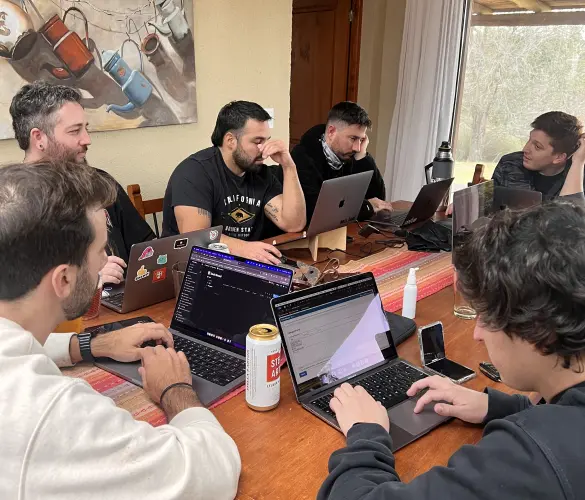
Business / 11 min read
Business / 11 min read
How WordPress Outsourcing Can Help Scale Your Agency
WordPress development outsourcing is becoming more frequent and affordable every day, helping global digital agencies of all sizes scale their services without the long-term investment of hiring an in-house team.…
Read More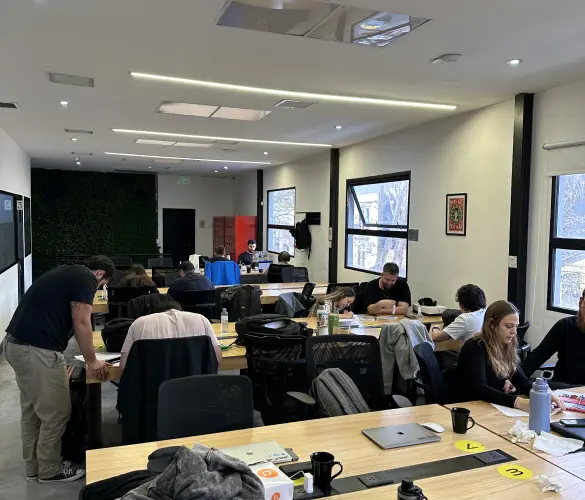
Business / 8 min read
Business / 8 min read
What Is a White Label WordPress Development Agency?
A white label WordPress development agency is a company of WordPress developers, QA analysts, and project managers who provide outsourced services to digital agencies that lack a development team. Importantly,…
Read More
